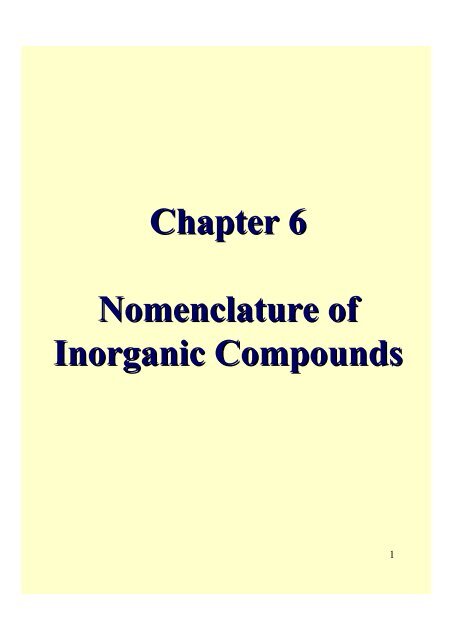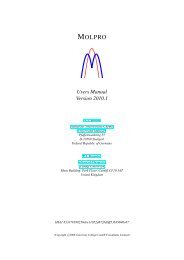Chapter 6 Nomenclature of Inorganic Compounds
Chapter 6 Nomenclature of Inorganic Compounds
Chapter 6 Nomenclature of Inorganic Compounds
You also want an ePaper? Increase the reach of your titles
YUMPU automatically turns print PDFs into web optimized ePapers that Google loves.
<strong>Chapter</strong> 6<strong>Nomenclature</strong> <strong>of</strong><strong>Inorganic</strong> <strong>Compounds</strong>1
6.1 Common and systematic names6.1 Common and systematic nameschemical nomenclature – the system <strong>of</strong> namesthat chemists use to identify compoundscommon name2
system for inorganic nomenclature was devised byInternational Union <strong>of</strong> Pure and Applied ChemistryIUPACrules for naming inorganic substance3
6.2 Elements and ionselements occurring as polyatomic moleculeshydrogen H 2 chlorine Cl 2 sulfur S 8oxygen O 2 fluorine F 2 phosphorus P 4nitrogen N 2 bromine Br 2iodine I 2ioncation K K + + e -K potassium K + potassium ionMg magnesium Mg 2+ magnesium ionAl aluminum Al 3+ aluminum ionanion Cl + e - Cl -Cl chlorine Cl - chloride ion4
F fluorine F - fluoride ionBr bromine Br - bromide ionI iodine I - iodide ionO oxygen O 2- oxide ionN nitrogen N 3- nitride ioncharges <strong>of</strong> selected ions5
6.3 Writing formulas from names <strong>of</strong>compoundsa chemical compound must have a net charge <strong>of</strong>zer<strong>of</strong>ormula writing <strong>of</strong> ionic compoundsex. 6.1 write formula for(a) calcium chlorideCa 2+ Cl - CaCl 2(b) magnesium oxideMg 2+ O 2- MgO(c) barium phosphideBa 2+ P 3- Ba 3 P 26
6.4 Naming binary compoundsbinary compounds contain only two differentelementsA. binary ionic compounds containing a metalforming only one type <strong>of</strong> cationsNaClsodium chlorideCaBr 2 calcium bromideMg 3 N 2 magnesium nitrideLi 2 O lithium oxide7
B. binary ionic compounds containing a metal thatcan form two or more types <strong>of</strong> cationsIUPAC devised the Stock systemcation +1 +2 +3 +4 +5(I) (II) (III) (IV) (V)ex. FeCl 2 iron(II) chloride ferrous chlorideFeCl 3 iron(III) chloride ferric chlorideCuCl copper(I) chloride cuprous chlorideCuCl 2 copper(II) chloride cupric chlorideex.6.3 name the compound FeSiron(II) sulfideferrous sulfide8
C. binary compounds containing two nonmetalsSi B P H C S I Br N Cl O Fthe element that occurs first in this series iswritten and name first, the name <strong>of</strong> the secondelement retains the –ide endingLatin prefix indicates the number <strong>of</strong> atoms <strong>of</strong> theelement1 mono 2 di 3 tri 4 tetra5 penta 6 hexa 7 hepta 8 octa9 nona 10 decaex. N 2 O 3dinitrogen trioxideex. 6.4 name the compound PCl 5phosphorus pentachloride9
D. acids derived from binary compoundsex. HCl(g) hydrogen chlorideHCl(aq) hydrochloric acidH 2 S(g) hydrogen sulfideH 2 S(aq) hydrosulfuric acidflow chart for naming binary compounds10
6.5 Naming compounds containingpolyatomic ionspolyatomic ion – ion that contains two or moreelementssome common polyatomic ionsoxy-anionsper- -ate -ate -ite hypo- -iteSO2-4 sulfate SO2-3 sulfiteNO-3 nitrate NO-2 nitrite11
three common polyatomic cationsNH 4+ ammonium H 3 O + hydroniumHg2+2 mercury (I)name the compounds1. identify the ions2. name the cations in the order given3. name the anion12
6.6 Acidsacid formulas <strong>of</strong>ten begin with Hbinary acids HCl H 2 Soxy-acids H 2 SO 4 HNO 3polyatomic anion acid-ate -ic acid-ite -ous acid13
flow chart for naming polyatomic compounds14











![Hetero [6+3] Cycloaddition of Fulvenes with N-Alkylidene Glycine ...](https://img.yumpu.com/35423358/1/190x245/hetero-6-3-cycloaddition-of-fulvenes-with-n-alkylidene-glycine-.jpg?quality=85)




